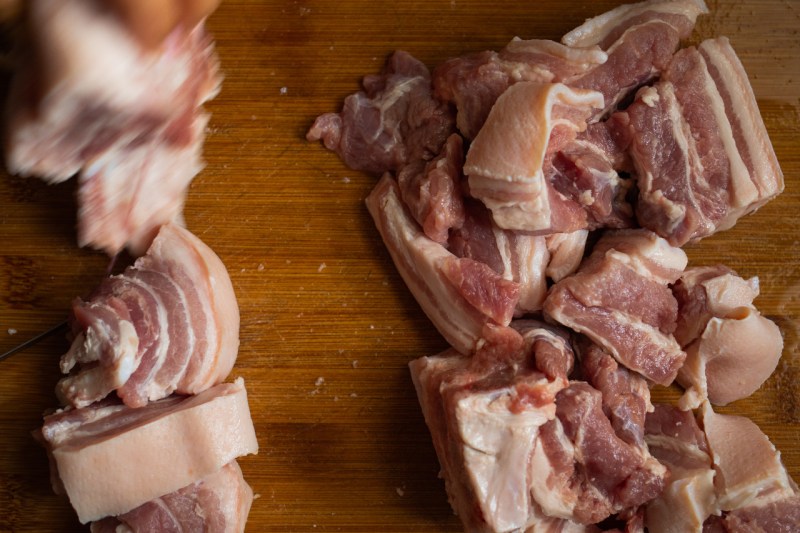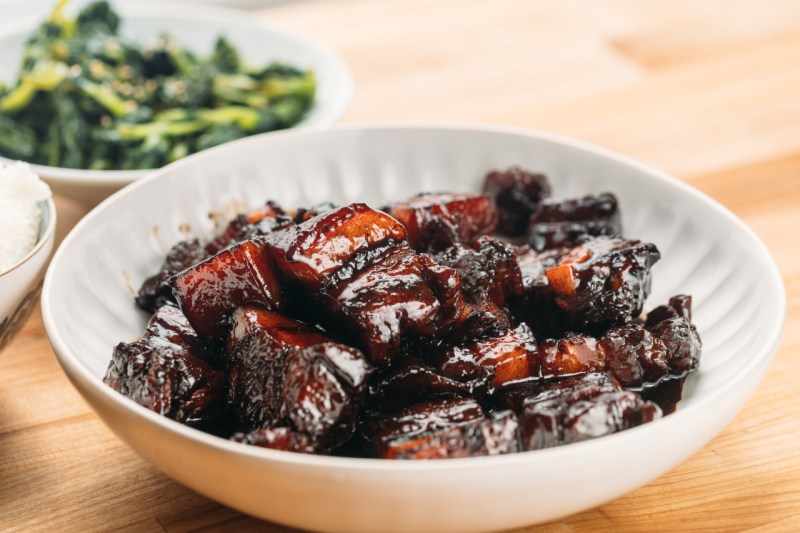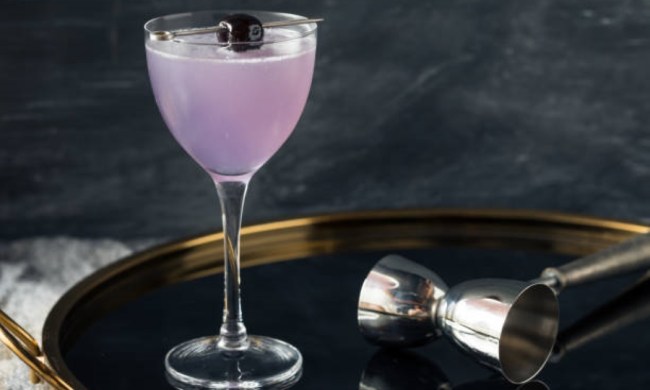
In Chinese cuisine, there’s a hearty, sweet and savory pork dish that beloved throughout the country — red-braised pork. This dish combines chunks of rich pork belly slow-cooked with plenty of savory soy sauce and sugar. The finished dish is not only meltingly soft, it also produces a lacquered, dark sauce that’s addicting when spooned over white rice. It’s the perfect food for dinner on any chilly evening. The best part? The pork is actually tastier when eaten the next day as the meat gets a chance to marinate further in the flavorful sauce.
Choosing the Meat

Traditionally, pork belly is the primary cut used for red-braised pork. A good cut of pork belly has the ideal combination of lean meat to fat. The addition of fat is very important for red-braised pork. Pork fat, when slow-cooked with soy sauce and sugar, will give the sauce a fatty richness. In China, red-braised pork is generally served for lunch or dinner with plenty of vegetables and rice.
For the perfect pork belly, be sure to obtain a thick cut, at least an inch thick. The best place to get thick slabs of pork belly will be at your local Asian market (Chinese or Korean markets are the best options). If an Asian market isn’t available, you can also order online from a specialty Asian grocery delivery service like Umamicart. For an authentic recipe, get pork belly with the skin still attached. When properly cooked, pork skin becomes gelatinous and soft. The combination of the slightly chewy skin with the soft fat and meat is perfect when executed correctly. This type of gelatinous texture is highly prized in Chinese cuisine. But free feel to remove the skin before cooking — the finished dish will still be tasty. If pork belly isn’t available or the cut isn’t thick enough, pork shoulder is a suitable replacement. Simply cut the pork shoulder into thick chunks (do not trim the fat).
All about the Seasoning
In Chinese cuisine, red-braising or red-cooking actually refers to a specific cooking style. This method is defined by simmering meat in a combination of sugar and dark soy sauce, producing a dark, “reddish” finished sauce. Any meat can be red-braised including beef, lamb, fish and even tofu.
The most important ingredients for a delicious red-braised pork is sugar (preferably Chinese rock sugar), Shaoxing cooking wine, and dark soy sauce. Although white sugar is also suitable, rock sugar is the superior option. Rock sugar has a mellow, more well-rounded sweetness that also adds a shine to the finished pork. Shaoxing wine is important for adding depth of flavor as well as mellowing the natural funk of pork. Finally, the dark soy sauce, which is a different product than standard soy sauce. Most red-braised pork recipes will call for two kinds of soy sauce — light and dark soy sauce. Dark soy sauce in Chinese cuisine is used primarily for cooking (not dipping like regular/light soy sauce). Dark soy is slightly thicker, less salty and much darker in color than light soy sauce. This addition is critical for imparting color to the pork. An important note when buying dark soy sauce — its critical to get Chinese dark soy sauce and not the Japanese version. Japanese dark soy sauce, labeled Koikuchi, is closer to light Chinese soy (although Japanese shoyu is thinner, a touch sweeter and less harsh). Japanese dark soy sauce will not produce the desired lacquered sauce for red-braised pork.
Red-braised pork will also differ in flavor and ingredients depending on the region in China. The red-braised pork in Wuxi, a city in Eastern China, is a sugar rush with an almost candy-like sweetness. In Hunan, a landlocked province in south central China, the red-braised pork is spicy and fragrant with chili peppers. In fact, Chairman Mao’s (a Hunan native) favorite dish was his region’s red-braised pork.
Umamicart’s Chinese Red-Braised Pork Recipe (Hong Shao Rou)

Umamicart is an online grocery store that specializes in delivering Asian products and ingredients in the Northeast region. From fresh produce to meats and sauces, Umamicart sources the best items and conveniently delivers them straight to your door.
This recipe from Umamicart is the Shanghai style of red-braised pork. Shanghai cuisine is all about the balance of sweet and savory, with an emphasis on maintaining the natural flavor of the ingredients. One of the greatest aspects of red-braised pork is the ability to add or adjust the flavors. Free feel to add dried red chili peppers for spice or whole star anise, cinnamon stick, ginger, and scallions for increased flavor.
Ingredients:
- 1 lb pork belly, cubed
- 3 tbsp cooking oil
- 2 tbsp sugar or white rock sugar
- 4 tbsp Shaoxing cooking wine
- 2 tbsp soy sauce
- 1 tbsp dark soy sauce
- 2 cups water
Method:
- Cut pork belly into 1 inch cubes.
- Blanche pork belly in boiling water for 5 minutes. Drain and rinse. This step is important to remove the impurities (blood) from the meat. The finished dish will have a cleaner taste so don’t skip this step.
- Heat oil in a large pot and melt in sugar over low heat.
- Add pork belly back into the oil, stir to coat the pork belly evenly with the sugar mixture.
- Add in light soy sauce, dark soy sauce, Shaoxing cooking wine, and enough water until all the pork belly is submerged.
- Simmer for 45-60 minutes until pork belly is tender.
- Serve with rice and enjoy!



